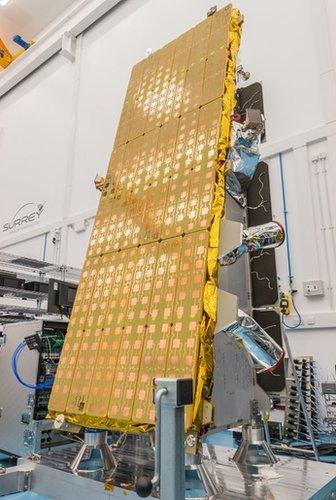Australia joins UK space radar mission
- Published
- comments

Radar satellites traditionally are much bigger and much heavier
Australia is to be a launch partner on the UK's innovative new small radar satellite, NovaSAR.
The spacecraft, which will track shipping and forestry change from orbit, is due to launch on an Indian rocket early next year.
Australia's main research organisation, CSIRO, external, has signed a 10% share in NovaSAR's data.
The deal comes on the heels of an announcement that the country will soon get a national space agency.
This future body will no doubt look to secure many more such collaborations, to enable Australian scientists and entrepreneurs to exploit the latest Earth observation information.
NovaSAR (PDF, external) has been built by Surrey Satellite Technology Limited, external in Guildford, in southern England, with the aid of a £21m UK government grant.

The S-band radar instrument itself has been developed by SSTL's parent, Airbus
The 3m-long platform, which looks like a cheese-grater, is regarded as an "operational demonstrator" - that is to say, it will showcase a capability but with the intention that its data is put to good use to develop services.
Radar works at wavelengths that allow it to pierce cloud to see the surface of the Earth in all weathers, and in darkness.
NovaSAR will use this vision to make forestry assessments in the tropics (frequent cloud) and at high latitude (poor light conditions); to support disaster relief (radar is very good at sensing flood water); and to monitor shipping routes.
This third application is enhanced by the addition of an Automatic Identification System (AIS) sensor onboard the satellite.
All ships over 300 gross tonnes are required to fit AIS transponders that broadcast details about their voyage.
Spotting from orbit those vessels that have their AIS disabled is often a sign of illegal actors, such as smugglers or trawlers attempting to net fish in no-take zones.
Radar plus AIS is seen as something of a killer application in maritime policing.
Australia's Commonwealth Scientific and Industrial Research Organisation (CSIRO) will get a 10% share of the tasking and data-acquisition capabilities of NovaSAR.
Dr Dave Williams from CSIRO said the deal represented a significant investment in Australia's space capability.
"The aim is to manage the NovaSAR satellite as a natural extension of the significant role CSIRO already plays in managing a range of national facilities, on behalf of the Australian community of scientists and for the benefit of the nation.
"Because we'll be able to direct the satellite's activity, it provides significant opportunities to support a wide range of existing research, further develop Australia's earth observation data analytics expertise, and create new opportunities in the field of remote sensing."
Dr Williams was the chief executive of the UK Space Agency before taking up his role at CSIRO.
Animation: NovaSAR has the look of a cheese-grater
NovaSAR is trying to address the interest in smaller, lower cost solutions to satellite radar.
Traditionally, these spacecraft have been large, power-hungry beasts that gather imagery which, by its very nature, leads to very big data volumes.
Managing all this in a compact package is challenging.
SSTL, working with its parent company Airbus, has produced what it thinks is one answer: something that is very capable but still compact enough (430kg) to fit on a cheaper rocket.
"We've gone for some specific radar applications, some specific modes," explained Luis Gomes, SSTL's commercial director. "But we'll aim to investigate other possibilities once we're in orbit.
"We'd like to have a go at radar interferometry, to sense landslides for example. It wasn't designed for that purpose but we want to see if it's possible," he told BBC News.
A number of companies are building spacecraft that are much smaller even than NovaSAR.
Capella Space (US), external has plans for a radar constellation based on cubesats - satellites with bodies that are built from 10cm blocks. And ICEYE (Finland), external is looking to platforms that are in the 100kg class (microsatellites).
The SSTL/CSIRO deal was signed in Adelaide on Tuesday at the International Astronautical Congress, external.
Jonathan.Amos-INTERNET@bbc.co.uk, external and follow me on Twitter: @BBCAmos, external